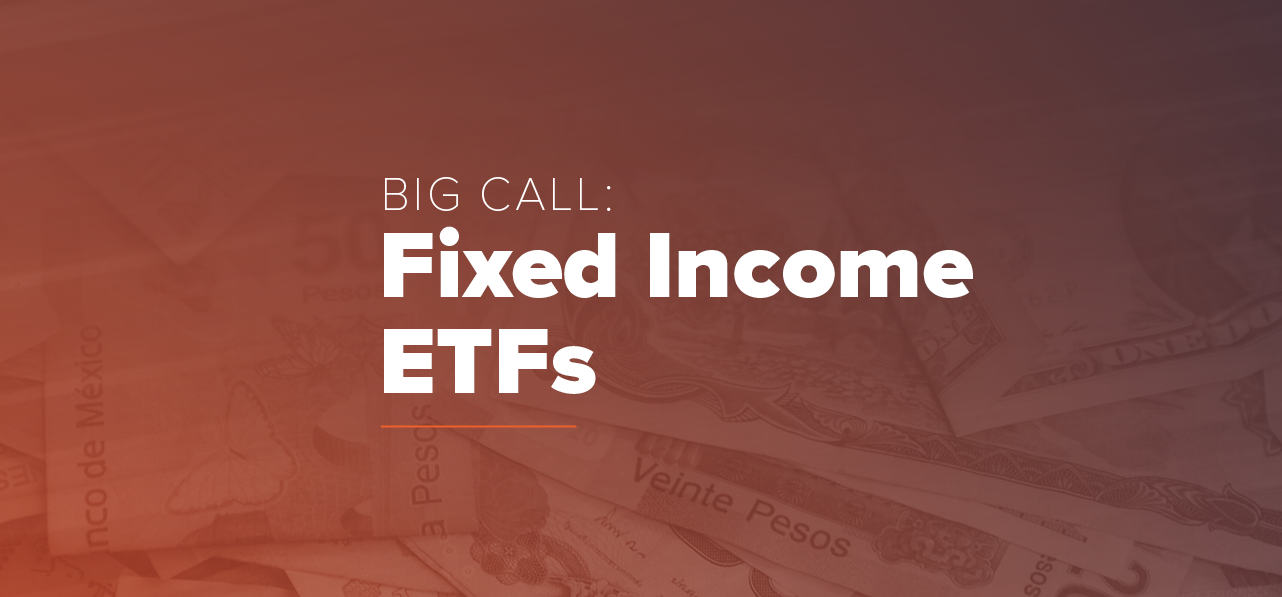Under the shadow of rising global inflation, attendees at ETF Stream'sBig Call: Fixed Income ETFs event had plenty to chew on in the nascent world of fixed income ETFs as investors continue to hunt for yield in a low return environment.
The event analysed the challenges currently facing global bond markets – China’s perceived control, the threat of rising inflation and the search for yield – while attempting to square the circle of sovereign bonds and ESG.
Fixed income ETFs have soared in recent years. With the market now totalling $375bn assets under management (AUM), many are predicting it to be the biggest growth asset class due to the sheer scale of the bond market.
However, with US inflation data spiking to its highest level since 2008, the Federal Reserve will be walking a policy tightrope in the coming months, leaving investors second-guessing how to position their portfolios.
In a panel discussing how investors need to navigate the inflationary landscape, Jean-Paul Jaegers, head of asset allocation at Barclays Investment Solution, said there are so many profound economic changes – including in employment and wages – it is “very difficult to see whether inflation is transitionary or permanent”.
“At the moment it is so important for investors to see at what point inflation comes down and determine whether it is indeed transitionary, because asset prices have no inflationary risk premium embedded at the moment,” he said.
Guy Foster, chief strategist for investment solutions at wealth manager Brewin Dolphin, added that while inflation-linked bond strategies provide insurance to rising inflation, they are structurally overvalued. Instead, he urged investors to target “anything that gives exposure to breakevens in a bid to hedge against inflation.
“The bond bull market has made it easier to have inflationary protection and make you feel like a genius,” he said. “But now it will be more challenging, and you have to be more creative about how you get protection. Recognising the complexity of the assets you are invested in will take you a long way, but you have to be active about it.”
One of the ways Foster said he is looking to achieve this is through US inflation-linked bonds and TIPS, as you are “getting paid to hedge back into sterling”.
On the flip side, Jaegers is considering adding real assets to his portfolio – along with inflation-linked bonds – rather than volatile commodities and benign sovereign bonds.
Both agreed however that you would be hard-pressed to find an investor who is upping their exposure to fixed income in the current climate. In fact, Jaegers said his investment team have been actively decreasing their allocation to fixed income, and have been for some time.
“To increase exposure to fixed income would not just a stock market sell-off in isolation. A potential taper tantrum matters a lot. We have seen the fastest reduction in Fed purchases over the past year, but the real surprise would be if they shrink their timetable. We are looking at the end of 2022.”
The hunt for yield
With investors seemingly turned off fixed income in the current inflationary environment, many are looking at different areas of the market in the hunt for yield, as discussed in the following panel.
Paul Syms, head of EMA ETF fixed income product management at Invesco, argued the inflation story may well be a more prolonged one and therefore investors should be targeting short duration in the hybrid space, an area that has been less affected by quantitative easing and central bank policies.
“The non-traditional areas of the market are currently the most interesting. AT1 bonds have been very successful this year and we have seen a lot of inflows, offering an attractive yield with relatively low duration,” he said.
“While 3.3% may not look as attractive as it did a while ago, it is still relatively attractive compared to investment grade credit,” he added.
Mark Northway, investment manager at Sparrows Capital, agreed that a short duration strategic play was necessary in the current environment as fixed income starts to play the role of “cash under the bed”.
“Something around four- to five-year duration and you will be replenishing portfolio that gives you yield; anything longer, you will take a hit,” he said.
China’s growing role
One area of the market investors are increasingly trying to understand is China. Ainsley To, head of multi-asset at Credo Wealth, said he views the region as a strategic diversification play. “We have some exposure as it has leaked into global benchmarks. From our perspective, there is a diversification benefit there,” he said.
Syms added: “It does have low correlation to developed markets, so you do get the diversification benefits. You are also getting a pickup in yield in China at the moment around 3%, relative to the global aggregate which is about 1%.”
In a separate panel looking at selection and innovation of ETFs, Andrew Limberis, investment manager at Omba Advisory & Investments, agreed that China was an area of interest, noting that a majority of bonds that yield above 2.5% come from China.
“We are not betting the house on China. There are risks, but it is an area that we like,” he said.
Michael John Little, CEO of Tabula said China is taking up an increasing share of the corporate bond space, currently a $1.2trn market, that many are not investing in and alluded to the fact that the highly indebted property giant Evergrande could be spooking investors.
“It is a great time for China to be facing issues. There are very little external influences and it will mostly affect domestic markets. The [bond] returns are good enough to analyse the market and make your own decisions.”
Despite this, China continues to be a divided hunting ground for investors who remain split on the risks involved in betting on a largely opaque market.
Peter Sleep, senior investment manager at 7IM, said: “It is unclear what is going to happen to companies like Evergrande, and ratings agencies are not giving accurate ratings.
“Chinese corporates is an area we will be watching, but on the fixed income side, it is too much of a wild west,” he added.
Delivering a keynote on how China's economy affects the global bond market, Michael Howell, CEO of CrossBorder Capital, noted China's balance sheet has flatlined since 2018 as the central bank shifts from targeting high growth to stability in contrast with the West.
“China may be doing the right thing by trying to get rid of its debt and not trying to raise new debt. This is one of the reasons we like fixed income there,” he said.
Shaking up the bond market
One area of the market that is experiencing growth, particularly in the US, is active ETFs.
First Trust Global Portfolios holds roughly $40bn in active ETFs, 80% of which is in fixed income. The firm’s CEO, Derek Fulton, said clients appreciate the strategy’s ability to go off benchmark, as well as their potential to add security and value.
“Active ETFs are a source of growth in the US and one of the rationales is tax efficiency compared to mutual funds. We have seen the same if not higher rate of growth in active ETFs – not just born out of tax efficiency but also returns,” he said.
Extracting alpha with fixed income in the current environment also requires some innovative thinking.
In a separate fireside chat, Matt Brennan, head of investment management at AJ Bell, said investors can generate 20-30 basis points via lending of the ETFs themselves, not just through the securities lending done by the issuers.
He said: “We are seeing this grow quickly and replace the futures market on the fixed income side. Generating alpha never comes without risk, but we think engaging on the securities lending side is a way to enhance returns in a low yield world.”
Over the past three years the ETF lending space has risen from £30bn to £70bn, Brennan highlighted.
When it comes to the nuts and bolts of the ETF fixed income market, Dan Izzo, CEO of market maker GHCO warned the global bond market is “stuck in the 80s” when it comes to prices discovery, an area the firm believes is ripe for disruption.
“It is not very modern, and there is no way you can do what we do without pushing tech to improve,” Izzo, said.
ESG's time to boom?
Having lagged far behind equities in its uptake in ESG, fixed income ETFs have made up considerable ground throughout 2021. The asset class pulled in €13.4bn as at the end of August, versus €12.2bn for vanilla strategies, according to data from Bloomberg Intelligence.
Ilia Chelomianski, portfolio manager, systematic fixed income, at Fidelity International, said performance has been the largest driver behind the flows while regulators’ spark to life has also given confidence to investors.
Despite this, fundamental challenges around engagement and greenwashing in the fixed income space are front and centre in investors’ minds, particularly in the sovereign space.
Chelomianski added: “Sovereign engagement is significantly more complicated; it is possible, but more of an issue for emerging markets.”
“You need to be prepared to take your time, as none of the changes are happening fast, and there is a misalignment in targets from emerging market investors and emerging market governments,” he explained
Delivering a keynote on how to square that circle, Carmen Nuzzo, head of fixed income at Principles for Responsible Investing, accepted that there were challenges including political sensitivity, and size and time horizons, but encouraged investors to work collaboratively in engaging with sovereigns.
She said: “When you try and engage with sovereigns it could also be with opposition parties, central banks, ministries and also non-government stakeholders such media, think tanks and trade unions to form a view more than anything else.”















